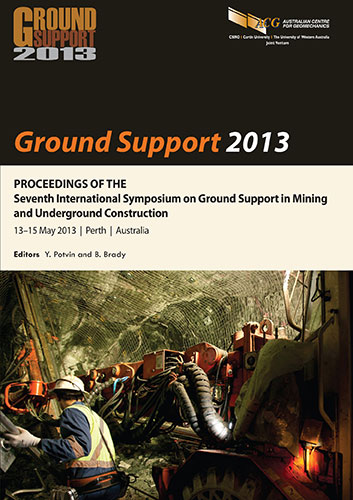A rapid method for highlighting shotcrete performance issues in underground mines

|
Authors: Doolan, JP; Hulls, IR Paper is not available for download Contact Us |
DOI https://doi.org/10.36487/ACG_rep/1304_41_Doolan
Cite As:
Doolan, JP & Hulls, IR 2013, 'A rapid method for highlighting shotcrete performance issues in underground mines', in Y Potvin & B Brady (eds), Ground Support 2013: Proceedings of the Seventh International Symposium on Ground Support in Mining and Underground Construction, Australian Centre for Geomechanics, Perth, pp. 597-607, https://doi.org/10.36487/ACG_rep/1304_41_Doolan
Abstract:
An underground mine was experiencing slower than acceptable re-entry times, i.e. in excess of four hours, to their priority development heading. This was due to slow setting of the accelerated shotcrete being sprayed in-cycle as part of the ground support system. A QA/QC investigation of the shotcrete used semi-adiabatic calorimetric testing to determine the hydration efficiency and set time effects of the shotcrete with different admixtures and cements to identify causal factors for the slow setting. Calorimetric testing, typically used in the civil and construction industry as a QA/QC measure for conventional high performance concrete, produces heat of hydration curves and monitors temperature rate rises over time to provide indications of early age behaviour and long term performance. Initial testing was completed onsite using a number of small scale mix designs, tested using an F-Cal Field Calorimeter, with heat of hydration results available within 12 hours. Calorimetry was successful in determining the most likely factors leading to slow setting, which were concluded to be cement type and super plasticiser performance. The calorimetric testing accelerated the QA/QC investigation, when compared to in situ batch testing, and allowed the mine operation to rapidly resolve the slow re-entry times and significantly increase development advance rates through implementing changes to the shotcrete mix design.
References:
ASTM (2008) ASTM International, ASTM C 1679-08 Standard Practice for Measuring Hydration Kinetics of Hydraulic Cementitious Mixtures Using Isothermal Calorimetry, ASTM Standard, ASTM International, West Conshohoken, PA, Vol. 04.01.
Bernard, E.S. (2008) Early-age load resistance of fibre reinforced shotcrete linings, Tunnelling and Underground Space Technology, Vol. 23, pp. 451–460.
wps/wcm/connect/website/bulk/resources/2af29c80463cd08f90649fd85ad4414b/CA0628+General+Blended+Cement.pdf.
Dight, P. and Hulls, I.R. (2009) Maturity and shotcrete strength for early re-entry, in Proceedings First International Seminar on Safe and Rapid Development Mining (SRDM), P. Dight (ed), 6–7 May 2009, Perth, Australia, Australian Centre for Geomechanics, Perth, pp. 81–100.
Guirguis, S. (1998) Cements – Properties and Characteristics, Cement & Concrete Association of Australia, viewed 22 January 2013, .
NCPTC (2008) National Concrete Pavement Technology Center, Cement Hydration: The Basics, National Concrete Pavement Technology Center, Aimes, viewed 12 January 2013, Hydration Basics.pdf.
Sandberg, P. and Walsh, W. (2010) Use of calorimetry to select materials for shotcrete, in Proceedings Third International Conference on Engineering Developments in Shotcrete, E.S. Bernard (ed), 15–17 March 2010, Queenstown, New Zealand, CRC Press, Leiden.
Sandberg, P. and Roberts, L. (2005) Cement-Admixture Interactions Related to Aluminate Control, Journal of ASTM International, ASTM International, Vol. 2, No. 6, June 2005, 14 p.
© Copyright 2025, Australian Centre for Geomechanics (ACG), The University of Western Australia. All rights reserved.
View copyright/legal information
Please direct any queries or error reports to repository-acg@uwa.edu.au
View copyright/legal information
Please direct any queries or error reports to repository-acg@uwa.edu.au